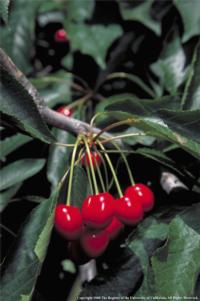English colonists first brought cherry trees to the United States in 1629. They were later introduced to California by Spanish missionaries. Cherry production has been well established in the San Joaquin and Santa Clara Valleys since the 1800s (California Cherry Board). California has the second largest sweet cherry industry in the U.S. with
82,000 tons produced on 33,000 planted acres in 2013 at a market value of $265,966,000 (USDA 2014). California growers have an advantage over producers in other states because they produce fruit from late April to late June, which arrives first to U.S. markets (USDA 2014). Approximately 25 – 35% of California sweet cherry production is sold to export markets (USDA 2012).
Domestic Sour and Sweet Cherry Production

Cherries belong to the Rosaceae family, along with other stone fruit crops such as almond, apricot, peach and plum (California Cherry Board). The two commonly cultivated cherry species are sweet cherry (Prunus avium L.) and sour cherry (Prunus cerasus L.). In the U.S., sweet cherry production has increased by 20% from the early 2000s to 70% of total domestic cherry production in 2013 (USDA 2014). In California, the primary cultivar with dark red fruit is Bing, while Rainier is the common cultivar with lighter, blushed fruit (California Cherry Board). The number of varieties grown in the state is increasing annually, mainly for adaptation to lower winter chilling conditions in the Southern San Joaquin Valley and elsewhere, greater resistance to rain-cracking, and large size, good firmness and retention of fruit stems. There is substantial interest in developing mechanical harvest of stem-on and stem-free sweet cherries. Research is being conducted to reduce dependence on labor, particularly in Michigan and Washington. California production is focused on sweet
cherry. The majority of sour cherries are grown in Michigan, although some sweet cherries are also produced there. Approximately ¾ of sweet cherry production is sold to the fresh market. Cherries that do not meet strict fresh market standards are processed. Processed sweet cherries are commonly brined and sold as Maraschino cherries to be used in confectionary foods (e.g. desserts and drinks), while sour cherries sold for processing are mainly frozen. Other methods of processing include canning, converting the fruit into juice or wine, or drying (ERS 2012).
Ideal Climate and Soil Conditions
Cherry trees require specific soil conditions for commercial cultivation. Cherry grows best in deep, medium-textured soils, with good drainage, low alkalinity, and low salinity (UC IPM Website: Pests in Gardens and Landscapes). Cherry trees do not tolerate waterlogged soils, regardless of the rootstock used (Long and Kaiser 2010). In California, cherry trees grow well in locations with long, warm summer days and cool nights. During the growing season, excessively high temperatures can cause rapid growth and fruit deterioration during the current season (Crisosto et al., 2003) and high rates of fruit doubling and spurs (small side fruit formed on the normal fruit) the following growing season (Bethell 1988). In late winter, normal bloom and bud break require temperatures no lower than 20°F (Bethell 1988) because cherry is highly susceptible to frost damage (Lang 2001). However, adequate chilling is required to break dormancy. If the required chill hours have not been reached rest-breaking agents can be used to help offset the deficiency (Glozer 2010). Once adequate winter chilling (with or without rest-breaking agents) has been experienced, moderately warm spring temperatures without excessive heat (more than about 75°F), cold (prolonged temperatures below the mid-50’s °F), or frost is needed for even bloom development and good overlap of pollinizer varieties to set a viable crop.
Fruit Development
Cherry trees produce flowers and fruit primarily on spurs that are at least two years old. Fruit growth occurs for approximately 60 days after bloom (Lang 2001), and fruit is mature within 100 days of pollination (UC Master Gardener Program, 2013). Fruit must ripen on the tree for proper flavor development, as cherries do not continue to ripen after harvest. Pre-harvest rains are problematic because they cause the fruit to crack, making them difficult to market and considerably more susceptible to decay (Mitcham and Crisosto 2002). When rain occurs and penetrates the skin, fruit burst open, which can result in 90% of crop loss. This problem is especially challenging in firm cherry cultivars that have small crop yields (Brown et al., 1989).
